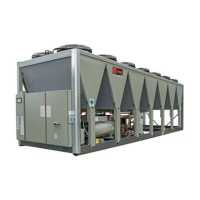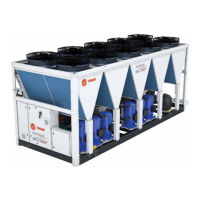Do you have a question about the Trane Sintesis RTAF HE series and is the answer not in the manual?
Highlights potentially hazardous situations that could result in death, injury, or property damage if not avoided.
Lists recommendations for maintenance and service visits to avoid hazards and ensure safe operation.
Details steps for inspecting the unit upon delivery and reporting any damage or shortages.
Lists responsibilities for foundation, rigging, isolation, electrical, and water piping installations.
Provides detailed technical specifications for RTAF 090-245 standard efficiency units across various configurations.
Details technical specifications for RTAF 090-185 standard efficiency units, including electrical and compressor data.
Provides technical specifications for RTAF 090-245 standard efficiency chillers with AC Extra Low Noise configurations.
Outlines general contractor responsibilities for installing RTAF units, including piping and electrical connections.
Describes the conditions required to enable free cooling operation, including outdoor air and water temperatures.
Provides a checklist of procedures to verify after unit installation and before starting the unit.
Specifies the required voltage, allowable fluctuation, and imbalance for the unit's power supply.
Explains the importance of proper motor rotation and provides steps to check phase sequence.
Outlines the step-by-step process for starting the Sintesis RTAF chiller for daily operation.
Provides instructions for preparing and starting the unit at the beginning of the cooling season.
Details procedures for safely restarting the unit after a period of extended shutdown.
Emphasizes proper refrigerant handling, recovery, recycling, and minimizing emissions according to regulations.
Highlights the importance of proper oil and refrigerant charge for unit operation, performance, and environmental protection.
Details the steps for isolating refrigerant charge on the low side of the system for compressor servicing.
Provides guidelines for cleaning condenser coils, emphasizing proper agents and techniques to avoid damage.
| Category | Chiller |
|---|---|
| Refrigerant | R-134a |
| Compressor Type | Screw |
| Dimensions (L x W x H) | Varies by model |
| Weight | Varies by model |
| Series | RTAF HE series |
| Cooling Capacity Range (Tons) | 150 - 400 |
| Operating Temperature Range | 40°F - 110°F |
| Water Flow Rate | Varies with model and application |
| Voltage Options | 460V/3Ph/60Hz |












